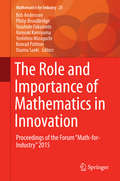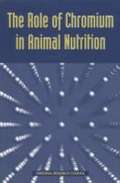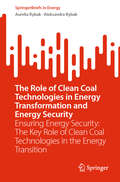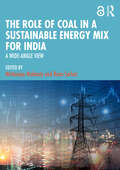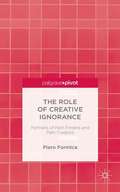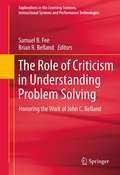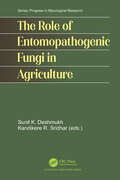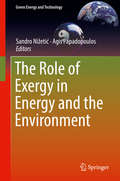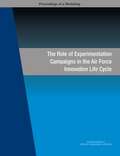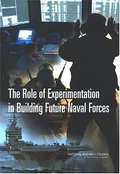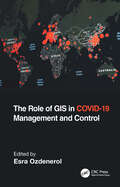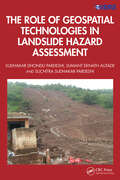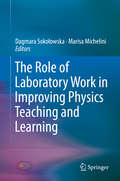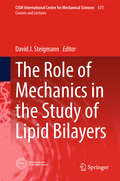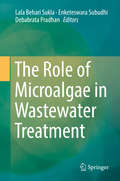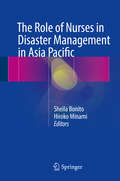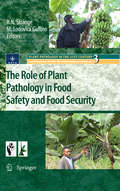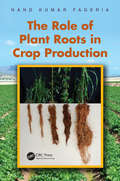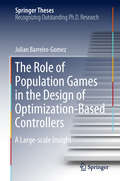- Table View
- List View
The Role and Importance of Mathematics in Innovation
by Bob Anderssen Philip Broadbridge Yasuhide Fukumoto Naoyuki Kamiyama Yoshihiro Mizoguchi Konrad Polthier Osamu SaekiThis book is a collection of papers presented at the "Forum Math-for-Industry 2015" for which the unifying theme was "The Role and Importance of Mathematics in Innovation", held at the Institute of Mathematics for Industry, Kyushu University, October 26-30, 2015. The theme highlights two key roles that mathematics plays in supporting innovation in science, technology, and daily life, namely, needs-based and idea-based. For the former, mathematics assists with sorting through the possibilities and putting matters on a more rigorous foundation, and for the latter, mathematical models of the possible implementations play a key role. The book gives excellent examples of how mathematics assists with stimulating innovation and, thereby, highlights the importance and relevance of the concept Mathematics_FOR_Industry. The contents of this volume address productive and successful interaction between industry and mathematicians, as well as the cross-fertilization and collaboration that result when mathematics is involved with the advancement of science and technology.
The Role of Agriculture in Climate Change Mitigation
by Lucjan PawłowskiAccording to IPCC reports, one of the greatest threats to the Earth ecosystems is climate change caused by the anthropogenic emissions of greenhouse gases, mostly carbon dioxide, mainly from the combustion of fossil fuels, cement production and land-use change which leads to an excessive temperature rise. Agriculture and forestry are responsible for quiet big emissions of greenhouse gases: CO2, CH4 and N2O, and have significant potential to reduce these emissions mainly through enhancement of CO2 absorption by terrestrial ecosystems. To evaluate the impact of agriculture on climate change, ruminant farming should be also taken into account. These animals emit considerable amounts of methane which has strong greenhouse effects. Methane emissions may be reduced by using appropriate feed for ruminants. Decreasing the meat consumption of these animals can also make an important contribution to reducing methane emissions. The methods for reducing greenhouse gas emissions through appropriate management of terrestrial ecosystems and animal husbandry are widely discussed in The Role of Agriculture in Climate Change Mitigation. The book will be of interest to academics, professionals and policy makers in environmental sciences.
The Role of Chromium in Animal Nutrition
by Committee on Animal NutritionThe American feed industry manufactures tons of dietary supplements and additives each year for inclusion in the diets of food-producing animals. Some scientists have suggested that chromium should be a key ingredient in nutritional supplements. Controversy exists, however, over whether chromium sources should be approved as feed additives and whether enough data exist to establish dietary requirements. Chromium use has been suggested to have positive impacts on farm profitability, and many animal health benefits have been attributed to chromium supplementation, including increased longevity; enhanced reproduction; decreased incidence of metabolic disorders, stress effects, and disease; reduced need for antibiotic usage; improved immune response; and lean carcass quality.This book addresses recent research on chromium in animal diets; metabolic interactions between chromium and other nutrients; assessments of form and species interactions; supplementation effects; bioavailability of chromium forms and sources; and effects of diet composition, stressors, and animal physiological status on chromium utilization. It also provides recommendations on the essentiality of dietary chromium in domestic animal species and guidelines for use of dietary chromium.
The Role of Clean Coal Technologies in Energy Transformation and Energy Security: Ensuring Energy Security: The Key Role of Clean Coal Technologies in the Energy Transition (SpringerBriefs in Energy)
by Aurelia Rybak Aleksandra RybakThis book presents the latest achievements in the field of clean coal technologies and shows how these innovations contribute to environmental protection and ensure stability of energy supplies. The book describes how clean coal technologies can revolutionize our energy future. From advanced mining methods to modern energy storage solutions, this book is a source of knowledge about sustainable development and technological innovation.
The Role of Coal in a Sustainable Energy Mix for India: A Wide-Angle View
by Mritiunjoy Mohanty and Runa SarkarAs India switches away from a coal-based to a more sustainable energy use pattern, which pathway will it adopt? What is the nature of challenges that it will face, and who will be affected? Who will gain? This volume offers insights into the steps and challenges involved in this transition and addresses some urgent questions about the possible pathways for India’s renewable energy generation. Including contributions from researchers, policymakers, and practitioners, it draws on different disciplines, ranging from science and technology to economics and sociology, and situates the issue of low carbon transition within an interdisciplinary framework. India has committed to gradual decarbonisation of its economy. This book takes this as its starting point and uses a wide-angle lens, incorporating macro as well as micro views, to understand the possible next steps as well as trade-offs that will inevitably be posed. It incorporates the perspectives of all stakeholders ranging from central and state governments, public and private sector firms, on the one hand, to individuals and local communities, on the other, to explore their role in the transition, their interests, and how these will change and evolve. This timely volume will be of interest to students and researchers of environmental studies, development studies, environmental economics, political studies, and Asian studies. It will also be useful to academics, practitioners, and policymakers working on issues related to climate change, sustainable development, energy policy and economics,and public policy.
The Role of Creative Ignorance: Portraits of Path Finders and Path Creators
by Piero FormicaThe Role of Creative Ignorance outlines the importance of creative ignorance using narrative examples of innovators and companies worldwide.
The Role of Criticism in Understanding Problem Solving
by Samuel Fee Brian BellandIn 1991, Denis Hlynka and John Belland released Paradigms Regained, a well received reader for graduate students in the field of educational technology. The Role of Criticism in Understanding Problem Solving updates some of those ideas initially proposed in Paradigms Regained, and extends the conversation into the contemporary discourse regarding problem based learning (PBL). Paradigms proposed the idea of criticism as a third method for the conduction of educational research, the first two being qualitative and qualitative. The concept of criticism as a tool for research is not well established in educational technology, although it is well established in other educational research traditions such as Curriculum Studies. Unfortunately, it is not always clear how criticism can be applied. This book views criticism as a way to step back and look at an educational intervention within educational technology through a particular critical lens. Criticism is viewed as a valuable approach to guiding meta analyses and theoretical studies, serving to prevent the proverbial "spinning of the wheels" that often happens in educational research. By indicating new potential research questions and directions, criticism approaches can invigorate educational research. This book revisits the ideals of criticism in order to establish their usefulness for studying educational technology interventions to support problem based learning. First, a few foundational chapters set the stage for the conversations on criticism. Then, the role criticism can play in enhancing analysis and interpretation of the PBL literature is explored. Finally, case studies addressing the central concepts of the text are presented and dissected. This book represents a complete overhaul and rethinking of the use of criticism as a method for understanding and furthering the research area of PBL within the field of Educational technology.
The Role of Entomopathogenic Fungi in Agriculture (Progress in Mycological Research)
by Sunil K. Deshmukh Kandikere R. SridharEntomopathogenic fungi are economically important fungi from environmental, agricultural, and human health perspectives. They are an alternative to chemical pesticides. They can also be used as biostimulants and biological control agents for mosquitoes and other insects. These fungi are also known to produce a variety of metabolites of industrial significance. They face challenges in the cultivation, fermentation, and purification of products. Their habitats and ecological niches are of special significance for ex situ conservation and the large scale of production of spores.This book reviews molecular aspects of the pathogenesis of entomopathogenic fungi, the development of mycoinsecticides, and its regulatory aspects. It addresses different aspects of entomopathogenic fungi, including host-pathogen interactions (susceptibility and resistance), fungus-insect and fungus-fungus dual interactions, phylogeny and taxonomy, biochemistry, and molecular basis of enteropathogenesis, market potential of entomopathogens, regulatory aspects, bioprospecting of fungi, fungi as crop bodyguards and in disease suppression, and consortia for the control of insect pests and pathogens in single crop systems.
The Role of Exergy in Energy and the Environment (Green Energy and Technology)
by Sandro Nižetić Agis PapadopoulosThis book is devoted to the analysis and applications of energy, exergy, and environmental issues in all sectors of the economy, including industrial processes, transportation, buildings, and services. Energy sources and technologies considered are hydrocarbons, wind and solar energy, fuel cells, as well as thermal and electrical storage. This book provides theoretical insights, along with state-of-the-art case studies and examples and will appeal to the academic community, but also to energy and environmental professionals and decision makers.
The Role of Experimentation Campaigns in the Air Force Innovation Life Cycle
by Engineering Medicine National Academies of SciencesThe Air Force (USAF) has continuously sought to improve the speed with which it develops new capabilities to accomplish its various missions in air, space, and cyberspace. Historically, innovation has been a key part of USAF strategy, and operating within an adversary’s OODA loop (observe, orient, decide, act) is part of Air Force DNA. This includes the ability to deploy technological innovations faster than do our adversaries. The Air Force faces adversaries with the potential to operate within the USAF’s OODA loop, and some of these adversaries are already deploying innovations faster than the USAF. The Role of Experimentation Campaigns in the Air Force Innovation Life Cycle examines the current state of innovation and experimentation in the Air Force and best practices in innovation and experimentation in industry and other government agencies. This report also explores organizational changes needed to eliminate the barriers that deter innovation and experimentation and makes recommendations for the successful implementation of robust innovation and experimentation by the Air Force.
The Role of Experimentation Campaigns in the Air Force Innovation Life Cycle: Proceedings of a Workshop
by Engineering Medicine National Academies of SciencesThe Workshop on the Role of Experimentation Campaigns in the Innovation Cycle was held in January 2016 to define and assess the current use of experimentation campaigns within the Air Force, evaluate barriers to their use, and make recommendations to increase their use. Participants at the workshop presented a broad range of issues, experiences, and insights related to experimentation, experimentation campaigns, and innovation. This publication summarizes the presentations and discussions from the workshop.
The Role of Experimentation in Building Future Naval Forces
by Committee for the Role of Experimentation in Building Future Naval ForcesThe Department of Defense is in the process of transforming the nation’s armed forces to meet the military challenges of the 21st century. Currently, the opportunity exists to carry out experiments at individual and joint service levels to facilitate this transformation. Experimentation, which involves a spectrum of activities including analyses, war games, modeling and simulation, small focused experiments, and large field events among other things, provides the means to enhance naval and joint force development. To assist the Navy in this effort, the Chief of Naval Operations (CNO) asked the National Research Council (NRC) to conduct a study to examine the role of experimentation in building future naval forces to operate in the joint environment. The NRC formed the Committee for the Role of Experimentation in Building Future Naval Forces to perform the study.
The Role of Fuels in Transforming Energy End-Use in Buildings and Industrial Processes (Synthesis Lectures on Engineering, Science, and Technology)
by Praveen Cheekatamarla Kyle Gluesenkamp Stephen Kowalski Zhenning Li Saad JajjaEnergy-efficient technologies are necessary to lower the carbon footprint for a transition towards clean energy in a sustainable manner. This book examines what role fuels have in the transformation of end-use in buildings and industrial processes. Energy-efficient technologies are necessary to lower the carbon footprint for a transition towards clean energy in a sustainable manner. Efficient utilization of primary energy resources, including renewables, to support the current and future energy needs while targeting grid resiliency, energy, and environmental security at an affordable cost is of significant value. The author analyzes heat pumps, fuel-driven thermal providers, and power systems configurations and looks at the sensitivity of the electrical grid's carbon intensity and tariff towards carbon footprint and energy costs compared with fuel-driven technologies. The role of low-carbon, zero-carbon, and carbon-negative fuels, such as power-to-gas (P2G), power-to-liquid (PtL), hydrogen, and biogas, in conjunction with polygeneration technologies, are discussed. This book also examines two different scenarios focused on the sensitivity of the pace of decarbonization of the electrical grid and fuel supply on operational energy-related carbon emissions.Compares electricity versus fuel as a primary energy sourceExplores the role of fuels in the decarbonization journey Examines the value proposition of currently available energy solutions
The Role of GIS in COVID-19 Management and Control
by Esra OzdenerolGeographic Information System (GIS) is one of the most important tools to help us understand public health and many aspects of our lives. Because of COVID-19, GIS has been brought into the spotlight more than ever before. People and civic leaders worldwide are turning to maps and real-time surveillance data to make sense of what has been happening in the world and to get answers to important questions on every aspect of this pandemic. This book examines the role of GIS in managing and controlling the spread of COVID-19 through 12 global projects and a multidisciplinary approach. It explains the innovative uses of GIS not only limited to data organization and data access, but also how improved GIS tools are used to make decisions, plan, and communicate various measures of control in both local and full-scale outbreaks during the COVID-19 pandemic. Features: Provides cutting-edge GIS visualization, spatial temporal pattern, and hot spot tracking applications used for predictive modeling of COVID-19. Includes real-world case studies with broad geographic scope that reflect COVID-19 trends in cases, deaths, and vaccinations. Provides lifestyle segmentation analysis on the risk of transmission of COVID-19 and spatial patterns of vaccination hesitancy. Highlights real-world issues brought to light with the help of GIS, such as social discrimination, inequalities in women’s access to mental health care, and analyzes the risk of transmission due to vaccination hesitancy. Shows the use of GIS and spatial analysis in pandemic mapping, management, and control from masking and social distancing to testing site locations accounting for at-risk and vulnerable populations. Discusses facilitating policy making with GIS. Edited by a very talented medical geographer and GIS Professor Dr. Esra Ozdenerol, this book highlights key GIS capabilities and lessons learned during the COVID-19 response that can help communities prepare for the next crisis. It is a great resource for industry professionals and experts in health care, public health and safety, disaster management, and for students, academics, and researchers interested in applying GIS and spatial analysis to the study of COVID-19 and other pandemics.
The Role of Geospatial Technologies in Landslide Hazard Assessment
by Sudhakar Dhondu Pardeshi Sumant Eknath Autade Suchitra Sudhakar PardeshiThis book is designed to provide a detailed, methodological framework for landslide hazard assessment. The focus is on various dimensions of landslide hazard assessment, including the terminologies used in landslide hazard analysis and landslide inventory systems used globally and their relevance in generating a complete and reliable landslide database for further analysis, supported by global case studies. It includes an overview of the methodological developments in landslide hazard assessment and role of geospatial technologies in landslide studies.Features: Helps readers to understand the technical details of geospatial techniques applied in hazard management. Deals with the practicalities of how to recognise and classify unstable terrain. Covers recent advances in landslide estimation, particularly the automated means of landslide susceptibility estimation. Explores methodological frameworks of landslide hazard assessment. Illustrates case studies from the United States, Europe, and Asia, including demonstrations of different methodologies of landslide susceptibility zonation. This book is aimed at researchers, graduate students, and libraries in geotechnical and environmental engineering.
The Role of Inter- and Intraindustry Trade in Technology Diffusion
by Dalia Hakura Florence JaumotteA report from the International Monetary Fund.
The Role of Laboratory Work in Improving Physics Teaching and Learning
by Marisa Michelini Dagmara SokołowskaThis book explores in detail the role of laboratory work in physics teaching and learning. Compelling recent research work is presented on the value of experimentation in the learning process, with description of important research-based proposals on how to achieve improvements in both teaching and learning. The book comprises a rigorously chosen selection of papers from a conference organized by the International Research Group on Physics Teaching (GIREP), an organization that promotes enhancement of the quality of physics teaching and learning at all educational levels and in all contexts. The topics covered are wide ranging. Examples include the roles of open inquiry experiments and advanced lab experiments, the value of computer modeling in physics teaching, the use of web-based interactive video activities and smartphones in the lab, the effectiveness of low-cost experiments, and assessment for learning through experimentation. The presented research-based proposals will be of interest to all who seek to improve physics teaching and learning.
The Role of Mechanics in the Study of Lipid Bilayers (CISM International Centre for Mechanical Sciences #577)
by David J. SteigmannThis book is the first collection of lipid-membrane research conducted by leading mechanicians and experts in continuum mechanics. It brings the overall intellectual framework afforded by modern continuum mechanics to bear on a host of challenging problems in lipid membrane physics. These include unique and authoritative treatments of differential geometry, shape elasticity, surface flow and diffusion, interleaf membrane friction, phase transitions, electroelasticity and flexoelectricity, and computational modelling.
The Role of Microalgae in Wastewater Treatment
by Lala Behari Sukla Debabrata Pradhan Enketeswara SubudhiThis book deals with the most emerging aspects of algal research with special reference to microalgae viz; diversity, mutations, genomics and metagenomics study, eco-physiology, culturing, microalgae for food and feed, biofuel production, harvesting of microalgae, separation, and purification of biochemicals, techno-economical assessment, microalgal biotechnology, algal-bacterial systems for wastewater treatment. It describes the complex issues associated with the above-mentioned areas with the intervention of cutting-edge biotechnological tools and techniques like next-generation sequencing methods, metabolomics, and bioreactor design and development. The chapters provide past developments, current information and future prospects of algal technology as an alternate avenue for waste water treatment and its potential for production of biofuel and nutraceuticals.
The Role of Nanoparticles in Plant Nutrition under Soil Pollution: Nanoscience in Nutrient Use Efficiency (Sustainable Plant Nutrition in a Changing World)
by Neetu Sharma Vishnu D. Rajput Tatiana Minkina Krishan K. VermaNanotechnology has shown great potential in all spheres of life. With the increasing pressure to meet the food demands of rapidly increasing population, thus, novel innovation and research are required in agriculture. The principles of nanotechnology can be implemented to meet the challenges faced by agricultural demands. Major challenges include the loss of nutrients in the soil and nutrient-deficient plants, which result in a lower crop yield and quality. Subsequently, consumption of such crops leads to malnourishment in humans, especially in underprivileged and rural populations. One convenient approach to tackle nutrient deficiency in plants is via the use of fertilizers; however, this method suffers from lower uptake efficiency in plants. Another approach to combat nutrient deficiency in humans is via the use of supplements and diet modifications; however, these approaches are less affordably viable in economically challenged communities and in rural areas. Therefore, the use of nano-fertilizers to combat this problem holds the greatest potential. Additionally, nanotechnology can be used to meet other challenges in agriculture including enhancing crop yield, protection from insect pests and animals, and by use of nano-pesticides and nano-biosensors to carry out the remediation of polluted soils. The future use of nanomaterials in soil ecosystems will be influenced by their capability to interact with soil constituents and the route of nanoparticles into the environment includes both natural and anthropogenic sources. The last decade has provided increasing research on the impact and use of nanoparticles in plants, animals, microbes, and soils, and yet these studies often lacked data involving the impact of nanoparticles on biotic and abiotic stress factors. This book provides significant recent research on the use of nano-fertilizers, which can have a major impact on components of an ecosystem. This work should provide a basis to further study these potential key areas in order to achieve sustainable and safe application of nanoparticles in agriculture.
The Role of Natural Antioxidants in Brain Disorders (Food Bioactive Ingredients)
by Ghulam Hussain Ali ImranOxidative stress and neuroinflammation are considered causative factors in various neurological disorders such as Parkinson’s and Alzheimer’s diseases. Antioxidants are chemicals that bind with oxidative species and nullify their effect from causing damage to biological molecules. Endogenous antioxidants are produced by our body, however most of them are obtained from external sources, primarily through diet, called dietary antioxidants. Major sources of antioxidants are brightly colored fruits, vegetables, cereals, legumes, and herbs. Other very effective sources are berries, green tea, and dark chocolate. These compounds have the potential to hinder neurodegeneration, reduce neuronal death and improve memory as well as cognitive functions. Based on the complex nature of antioxidants and oxidative stress, particular antioxidants such as vitamin E, vitamin C or β-carotene are beneficial in protecting cells, organs and tissues against oxidative damage.The Role of Natural Antioxidants in Brain Disorders describes various neuroprotective effects and their physiological phenomenon mediated by antioxidants to maintain and regulate the general health biomarkers against brain disorders. The important role of antioxidants, diet and lifestyle in managing brain disorders is covered, as is their use in conjunction with conventional therapies against oxidative stress. Both exogenous and endogenous antioxidants are explored in full. By focusing on the role of oxidative stress as a triggering mechanism for various brain disorders and the use of antioxidant foods in conjunction with traditional therapies in combating and preventing them, this is a valuable source for researchers in food science, nutrition, health science and physiology.
The Role of Nurses in Disaster Management in Asia Pacific
by Sheila Bonito Hiroko MinamiThis book documents how nurses have shown their dedication, courage, expertise and compassion in helping communities prepare for, respond to and recover from disastrous events. It aims to inspire and equip nurses and other health professionals to help people in disaster-affected areas and contribute to community resilience. The last decade (2005-2015) has been characterized by a number of overwhelming natural disasters - tropical storms, floods, earthquakes, tsunamis; and threats of emerging infectious diseases - SARS, MERSCoV and Ebola around the world. Countries from the Asia Pacific region, such as Australia, Cambodia, China, Indonesia, India, Japan, Nepal, Philippines, Solomon Islands, South Korea, Thailand and Vanuatu, have borne the brunt of the devastation caused by these catastrophic events. Nurses from these countries have stepped in providing emergency care in hospitals and in the field, addressing public health needs in evacuation centers, supporting epidemiologic surveillance and conducting health education, training and research, to help save lives and support communities build back better.
The Role of Plant Pathology in Food Safety and Food Security
by Maria Lodovica Gullino R. N. StrangeThis book views the vulnerability of our crops in general to devastating diseases as well as specifically the disease problems of two important staples, rice and cassava. Increased travel and increased transport of plant material throughout the world pose ever more significant risks to the health of our plants. These include not only the destruction of our food crops by pathogens which may be imported accidentally or maliciously but also their contamination by fungi that produce powerful toxins (mycotoxins). How we should respond to these challenges is the subject of several papers. Clearly, quarantine is an important measure by which the spread of plant pathogens may be at least delayed, if not curtailed altogether, but breeding plants for resistance is the mainstay for maintaining the comparative health and productivity of our crops. However, adequate resistance may not be available in the gene pool of a given species or genus and therefore the possibility of genetic modification arises, a topic treated in two of the papers.
The Role of Plant Roots in Crop Production
by Nand Kumar FageriaThe Role of Plant Roots in Crop Production presents the state of knowledge on environmental factors in root growth and development and their effect on the improvement of the yield of annual crops. This book addresses the role of roots in crop production and includes references to numerous annual crops. In addition, it brings together the issues and
The Role of Population Games in the Design of Optimization-Based Controllers: A Large-scale Insight (Springer Theses)
by Julian Barreiro-GomezThis book reports on the implementation of evolutionary-game theory in the design of distributed optimization-based controllers. First, it discusses how the classical population-game approach can contribute to and complement the design of optimization-based controllers. It shows how the features of this approach can be exploited to extend their capabilities in the solution of distributed optimization problems, and examines density games in order to consider multiple coupled constraints and preserve the non-centralized information requirements. Furthermore, it establishes a close relationship between the possible interactions among agents in a population with constrained information sharing among different local controllers. It also discusses coalitional games, focusing on the Shapley power index and proposes an alternative method of computing the latter, which reduces computational time, as well as a different way of finding it using distributed communication structures. All the proposed strategies are then tested on various control problems, such as those related to the Barcelona water supply network, multiple continuous stirred tank reactors, various unmanned aerial vehicle systems, and a water distribution system. This thesis, examined at the Universitat Politècnica de Catalunya and Universidad de los Andes in 2017, received the award for best thesis in control from the control group of the Spanish Committee of Automatic Control (CEA) in the same year.
